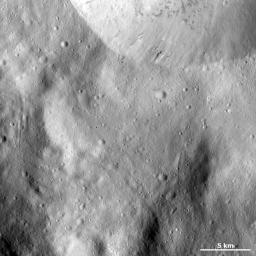This Dawn FC (framing camera) image shows part of the sharp, fresh rim of a large crater in the top part of the image. There is some bright material slumping towards the center of this crater but this is mostly overshadowed by the dark material, which has a splotchy appearance and is reasonably densely distributed across the part of the crater visible in this image. Around the middle part of the crater rim there are some boulders, which are identified by the dark shadows that they cast. These boulders are probably also slumping towards the center of this crater. The region surrounding this crater is reasonably smooth, which suggests that it is covered by fine-grained ejecta material.
This image is located in Vesta's Urbinia quadrangle and the center of the image is 63.3 degrees south latitude, 311.0 degrees east longitude. NASA's Dawn spacecraft obtained this image with its framing camera on Dec. 13, 2011. This image was taken through the camera's clear filter. The distance to the surface of Vesta is 272 kilometers (163 miles) and the image has a resolution of about 25 meters (82 feet) per pixel. This image was acquired during the LAMO (low-altitude mapping orbit) phase of the mission.
The Dawn mission to Vesta and Ceres is managed by NASA's Jet Propulsion Laboratory, a division of the California Institute of Technology in Pasadena, for NASA's Science Mission Directorate, Washington D.C. UCLA is responsible for overall Dawn mission science. The Dawn framing cameras have been developed and built under the leadership of the Max Planck Institute for Solar System Research, Katlenburg-Lindau, Germany, with significant contributions by DLR German Aerospace Center, Institute of Planetary Research, Berlin, and in coordination with the Institute of Computer and Communication Network Engineering, Braunschweig. The Framing Camera project is funded by the Max Planck Society, DLR, and NASA/JPL.
More information about the Dawn mission is online at http://www.nasa.gov/dawn and http://dawn.jpl.nasa.gov.

 Planetary Data System
Planetary Data System












